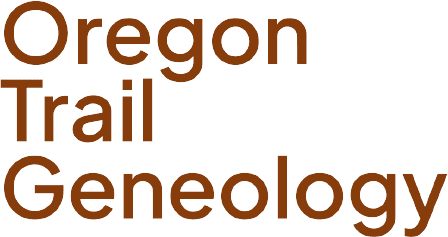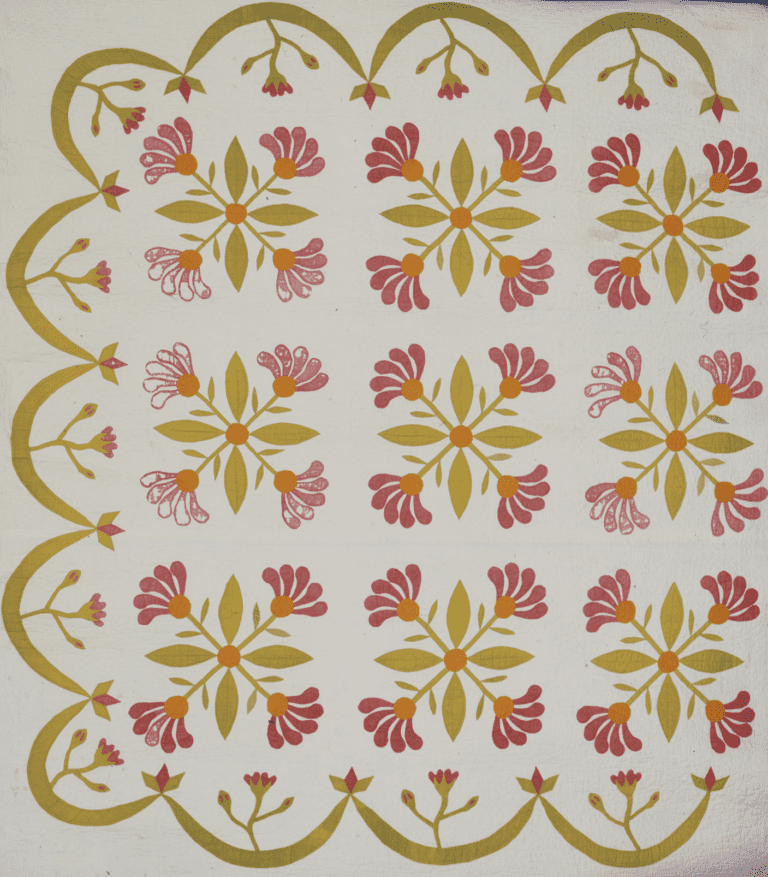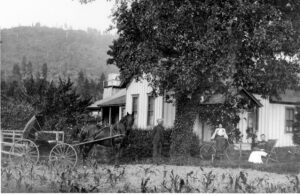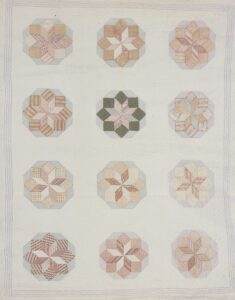In 1864, 8 yr. old Ersula Goddard left Missouri by ox and wagon to cross the plains. Traveling the Oregon Trail with her father, Blin Carlos Goddard, her mother, Demaris (McClain) Goddard, and three siblings, the family settled in Jackson Co., SW Oregon.
In 1852, when Robert Robison was 7 yrs. old, his father, John Robison, moved his family across the Oregon Trail. Like the Goddard’s, they settled in Oregon, first in Yamhill Co., then moved on to Jackson Co. in 1853. By 1874 the two families had met, and Ersula Goddard married Robert B. Robison, who died in 1880, and left her with three children, including Minnie who was born the year her father died. Ersula eventually married Willis John Dean in 1886, who, with Minnie and Ersula, are pictured above at the Dean homestead.
But this is really a story of two quilts, and how those quilts enabled me to find a lineage of Goddard’s that I did not know existed, and who are connected to my own line. Though a distant connection, Ersula “Sula” Isabelle Goddard is my 10th cousin, 3X removed.
The story also shows that many of the clues we might stumble upon, and often ignore, can open a bursting dam of family history. Typically, looking at other family trees, checking census records, and doing searches on genealogical websites can get us started on our family’s history. But to find the details of our ancestor’s lives, to learn how they lived, what they were interested in, what type of people they were, these are the details that layer and enrich our family trees.
Mary Bywater Cross, author of “Quilts of the Oregon Trail,” contacted me through this website and asked if I knew anything about the quilts or related families. She was instrumental in getting the Oregon Quilt Project of documented quilts into the Quilt Index. Little did I know the door she had opened to my own family. She prompted me to wonder about this Blin Carlos Goddard, a name I had never heard of after decades of researching the Goddard line. The more challenging questions, were, who had actually made the Honeysuckle, and when did it travel the Oregon Trail?
Around 1950, at the age of 80, Minnie (Robison) Colver, donated treasured family heirlooms to the Southern Oregon Historical Society. Among the items was the quilt, Honeysuckle, and along with it, a cryptic note that read, “Minnie Robison’s great-great aunts.” Furthermore, there was the story that Honeysuckle had also made the journey across the plains.
Obviously, the name “Goddard’ drew my attention, and it didn’t take me long to trace the ancestry of Minnie’s grandfather, Blin Carlos Goddard, back to a common ancestor in the 1500’s. Mary’s question about the quilt had unexpectedly brought an entire line of Goddard’s into my own family tree. More significantly to me, it showcased the first example I had found of the Goddard line embarking on the Oregon Trail.
The more difficult task has been to trace a particular quilt to the Oregon Trail and discover which family may have carried it with them. The single clue was “Minnie Robison’s great-great aunts.” Since I had already established her grandfather Blin C. Goddard’s lineage, I needed to build out the “side” families. Assuming the reference to “great-great aunts” was accurate, I knew I’d be looking at the sisters of her great grandfather Steven Goddard. Then the task would be to examine their lives, looking for clues of quilts or references to one of them passing on the quilt to Blin for his 1864 journey across the plains. I would also need to take a look at the sisters of her great grandmother, for in those days extended families tended to live close to one another, the family connections running deep, and many hands would have pitched in to help others prepare for the arduous journey to Oregon.
Another possibility is that Minnie was referring to great-great aunts on her husband’s side, that the quilt originated in the Robison family and was handed down to her after coming across the plains in 1852. A third, and least likely road to follow, is that she may have referred to the great aunts on her husband’s side, the Colvers, and while that may not be, it is exactly the kind of detail that cannot be cast aside until the evidence casts out that idea.
This then, is a classic example of genealogical research. Having read this far, you may wish to find the conclusion of the story, the final episode of a quilt that was handed from family member to family member as a memento of a time gone by, of family left behind while others risked the long journey to establish a new life in the Oregon Territory. But the story has no ending yet. That is often the way of family research. I do have more clues now. I have nine great-great aunts to research. There are still trail diaries to pursue (for example, the John Clark diary from the Oregon Trail journey of 1852 lists a “Robison” as part of the train’s roster). Each person examined may or may not lead to the quilt, but in the end, everything I learn will add a richness to the stories of these people’s lives, and ultimately, a richness to my own, for all of these people are family.






Kathleen Franks-Crabb
Absolutely fascinating.